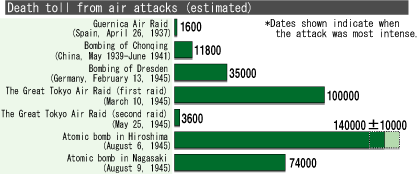(17)Why is the experience of Hiroshima and Nagasaki so unique?
The firebombing of Tokyo resulted in a large death toll, too, so why are Hiroshima and Nagasaki considered unique?
The horror of radiation is one factor
Death tolls from the atomic bombs, by the end of 1945, are estimated at 140,000 in Hiroshima and 74,000 in Nagasaki. In regard to loss of life, there doesn't seem to be an appreciable difference between these figures and the 100,000 people that were killed in the Great Tokyo Air Raid.
And yet the characteristics of an atomic bomb are significantly more cruel. Yozo Kudo, a professor at Tokuyama College of Technology and a researcher of the effects of air raids and the atomic bombs, explained to us, "Atomic bombs have extraordinary power and the radiation they emit has serious consequences."
On March 10, 1945, the Great Tokyo Air Raid involved 279 American B-29 bombers that firebombed the city with 1500 tons of incendiary bombs in two-and-a-half hours. By comparison, the atomic bomb that destroyed Hiroshima killed far more people--and it was just one bomb. This difference in deadly force between atomic bombs and conventional bombs is shocking.
Rising mortality due to the atomic bomb

We investigated the damage caused by radiation. The Radiation Effects Research Foundation in Hiroshima has conducted an assessment of life expectancy since 1950. To date, 93,000 A-bomb survivors have been compared with 27,000 others and the results reveal that the incidence of leukemia and cancer among A-bomb survivors is higher than that of the general population.
For example, when a person is exposed to one "Gray" of radiation (the average amount of annual exposure for Japanese is 0.002 Gray), mortality is 5.62 times higher for leukemia and 1.4 times higher for cancer.
The impact on succeeding generations
Because radiation affects human genes, there has been strong concern about the impact of radiation on the children and grandchildren of survivors. In terms of cancer and lifestyle-related disease, the Radiation Effects Research Foundation has found no clear influence in their analysis. However, Takanobu Teramoto, Executive Director of the facility, feels that, "Further research must be conducted to reach a more conclusive result."
A man who once lived in the area near the bomb's hypocenter, Tsuneo Kasai, remarked that atomic bombs are unique in that they "don't offer us any chance to escape." A large number of lives vanished in an instant, including his parents. He suspects they died before they even felt any danger.
On the other hand, Hiroko Takahashi, an associate professor at the Hiroshima Peace Institute at Hiroshima City University, told us, "It isn't really helpful to judge the damage done in these incidents by comparing the death tolls. This can prevent us from closely considering the afflictions suffered by the survivors as a result of radiation from the atomic bombs."
Perhaps it's true, then, that emphasizing the number of fatalities too strongly might lead some to conclude that the "damage in Hiroshima was not particularly unique". And this would be a grave error for the experiences of Hiroshima and Nagasaki have demonstrated the terrifying power of nuclear weapons and the horror of their radiation on human beings. Since then, nuclear weapons have not been used, but we must continue to convey the unique nature of these appalling weapons and appeal for their abolishment. (Takashi Kenda, staff writer)
- Incendiary bombs
Bombs that explode into flaming weapons. In the Great Tokyo Air Raid, "incendiary cluster bombs" scattered in the air as they fell and caused enormous damage.
- Research of life expectancy
Research conducted by the Radiation Effects Research Foundation, tracing the lives of people who lived in Hiroshima and Nagasaki in 1950. This research investigates the date of death, the cause of death, and whether or not they had developed cancer. It excludes the children of survivors and babies still carried in their mothers at that time. The project began in 1958 with 100,000 people and increased by 10,000 in 1968 and again in 1980.
- Gray
The unit used to measure the amount of radiation absorbed by the human body. Gray takes the type of radiation into account as it calculates the impact of that radiation.